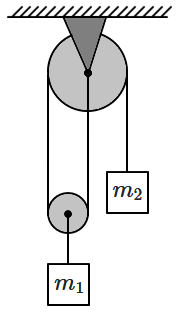Select Question Set:
A constant force \(F\) is applied to the string so that the \(3\) kg block does not move, but the \(5\) kg block moves horizontally. The acceleration of the \(5\) kg block is: (take \(g=10\) m/s2)

1.
\(6\) m/s2
2.
\(3\) m/s2
3.
\(1.5\) m/s2
4.
\(1.2\) m/s2
Subtopic: Application of Laws |
71%
Level 2: 60%+
Hints
The system shown in the diagram is in equilibrium. Assuming that the strings and pulleys are ideal, the ratio of the masses, \(\dfrac{m_1}{m_2}=\)


| 1. | \(4\) | 2. | \(2\) |
| 3. | \(\dfrac{1}{2}\) | 4. | \(\dfrac{1}{4}\) |
a,
Subtopic: Application of Laws |
64%
Level 2: 60%+
Hints
Select the correct option based on statements below:
| Assertion (A): | Newton's law of action and reaction is a consequence of Newton's law of inertia. |
| Reason (R): | Newton's law of inertia implies that any body that is not acted upon by external forces cannot change its state of rest or uniform motion. |
| 1. | (A) is True but (R) is False. |
| 2. | (A) is False but (R) is True. |
| 3. | Both (A) and (R) are True and (R) is the correct explanation of (A). |
| 4. | Both (A) and (R) are True but (R) is not the correct explanation of (A). |
Subtopic: Newton's Laws |
64%
Level 2: 60%+
Hints
Assume that at the moment of lift-off, the rate at which gases are ejected is \(r\) (kg/s) and the speed of the exhaust is \(u\) (m/s). If the rocket has a mass \(m\) (with fuel and payload) and its acceleration is zero, but it has lifted off, then,

1. \(mg=ru\)
2. \(mg=ru^2\)
3. \(g=ru\)
4. \(mg=r^2u^2\)

1. \(mg=ru\)
2. \(mg=ru^2\)
3. \(g=ru\)
4. \(mg=r^2u^2\)
Subtopic: Newton's Laws |
77%
Level 2: 60%+
Hints
A block of mass \(5\) kg requires a minimum horizontal force of \(20\) N to cause it to move. Take \(g=10\) m/s2. Let \(\mu_s\) be the coefficient of static friction, and \(\mu\small{_ k}\) be that of kinetic friction.

1. \(\mu_s=0.4\)
2. \(\mu_s=\mu{\small_k}=0.4\)
3. \(\mu{\small_ k}=0.4\)
4. \(\mu_s\geq0.4\)

1. \(\mu_s=0.4\)
2. \(\mu_s=\mu{\small_k}=0.4\)
3. \(\mu{\small_ k}=0.4\)
4. \(\mu_s\geq0.4\)
Subtopic: Friction |
53%
Level 3: 35%-60%
Hints
Given below are two statements:
| Statement I: | Given that the magnitude of the acceleration of a body is constant, the force acting on it must be constant. |
| Statement II: | Newton's second law leads to the statement that the acceleration of a body is directly proportional to the net force acting on it. |
| 1. | Statement I is incorrect and Statement II is correct. |
| 2. | Both Statement I and Statement II are correct. |
| 3. | Both Statement I and Statement II are incorrect. |
| 4. | Statement I is correct and Statement II is incorrect. |
Subtopic: Newton's Laws |
Level 3: 35%-60%
Hints
The system of blocks is pulled up by force as shown in the figure. The force exerted on the \(3\) kg block by the connecting string is:


| 1. | \(80~\text{N}\) | 2. | \(60~\text{N}\) |
| 3. | \(40~\text{N}\) | 4. | \(100~\text{N}\) |
Subtopic: Application of Laws |
70%
Level 2: 60%+
Hints
A block is placed on a smooth horizontal surface, and forces are applied to it as shown in the diagram. Take \(g=10~\text{m/s}^2.\) The normal reaction acting on the block is:

1. \(100~\text N\)
2. \(60~\text N\)
3. \(40~\text N\)
4. \(20~\text N\)

1. \(100~\text N\)
2. \(60~\text N\)
3. \(40~\text N\)
4. \(20~\text N\)
Subtopic: Tension & Normal Reaction |
71%
Level 2: 60%+
Hints
Two bodies \(A,B\) having masses of \(1\) kg, \(2\) kg respectively are slid on a horizontal surface \((\mu=0.2)\) with the same initial speed \(5\) m/s. If they come to a stop after sliding distances of \(S_A,S_B\) then:
1. \(S_A=2S_B\)
2. \(S_B=2S_A\)
3. \(4S_A=S_B\)
4. \(S_A=S_B\)
1. \(S_A=2S_B\)
2. \(S_B=2S_A\)
3. \(4S_A=S_B\)
4. \(S_A=S_B\)
Subtopic: Friction |
71%
Level 2: 60%+
Hints
Unlock IMPORTANT QUESTION
This question was bookmarked by 5 NEET 2025 toppers during their NEETprep journey. Get Target Batch to see this question.
✨ Perfect for quick revision & accuracy boost
Buy Target Batch
Access all premium questions instantly
Given below are two statements:
| Statement I: | When a railway engine pulls a train and the system moves forward, the force exerted by the engine on the train is greater than that exerted by the train on the engine. |
| Statement II: | The normal force exerted by the ground on a man is the reaction force of the weight of the man. |
| 1. | Statement I is incorrect and Statement II is correct. |
| 2. | Both Statement I and Statement II are correct. |
| 3. | Both Statement I and Statement II are incorrect. |
| 4. | Statement I is correct and Statement II is incorrect. |
Subtopic: Application of Laws |
Level 4: Below 35%
Hints
Select Question Set:






